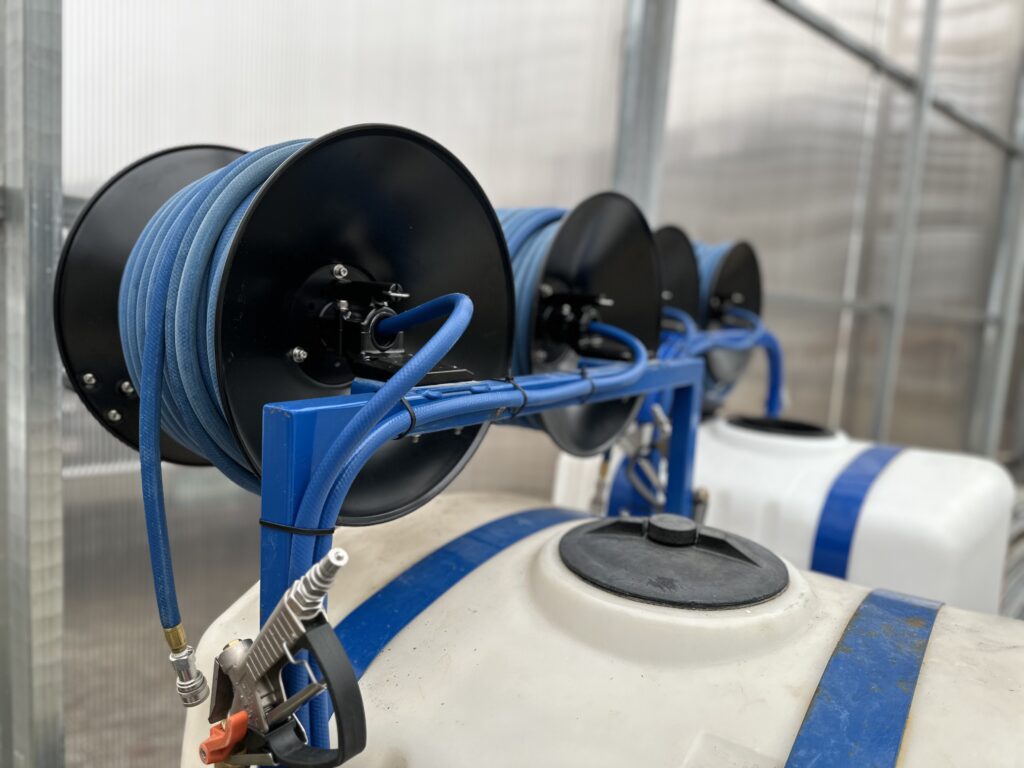Choosing a hose reel on your sprayer may seem like a minor part of the machine. However, as a major part of the user’s interaction with the equipment, it is an important component that has an impact on the operation of spraying.
Dramm has several types of hose reels available. On each of our machines, we offer our standard hose reel, available in several sizes to accommodate different lengths of hose. Our standard reel has several features that make it better, in our opinion, for the user.
First is the shape. Dramm reels have convex walls. The angle of these walls is 33˚. They are 33˚ for a reason: 33˚ is the angle that represents one hose-width wider per wrap of hose on the spool. When hose is wrapped on the reel, each subsequent wrap sits in the gaps created by the previous layer of hose. That causes half of the hose on each side to stick out beyond the previous wrap. With a flat-walled reel, this is not possible as the walls are not angled. This leaves a slight gap. As hose expands with pressure and gets pulled, often these gaps become pinch-points, trapping the hose and preventing easy unwinding.
By angling the walls of the reel, this pinching is largely avoided, allowing the user to unwind the hose with less trouble.
Most reels are positioned to pay-out the sides, allowing for easy access to aisle. For larger equipment, unable to fit down smaller aisles, this is the norm. On some smaller Dramm equipment, reels can be mounted either to allow the hose to pay-out to the sides or off the rear. This allows for growers pulling smaller equipment into aisles to pull the hose out directly down the aisle, easing overall operation.
Finally, customers with longer hoses often ask for a motorized reel to reduce strain in manually winding the hose. While this may seem like a good tool to help employees, these reels are expensive. To maximize the investment, we suggest spending a little more on a remote-winding reel. For approximately 20% more than the motorized reel alone, you add the feature of the hose winding automatically, as the grower sprays.
For example, a customer asked for a sprayer with a 300′ hose and a motorized reel. The customer intended to use the machine on an end-aisle in the greenhouse, moving the sprayer to the front of each row where they would pull out the 300′ as they spray down one side. As they walk back to the main aisle, they spray the other side of the row, leaving a loop of hose trailing them. Once they get to the end of the row, the stop and press the rewind button as the hose winds up.
In this case, it takes approximately 2 minutes to wind 300′ at a safe speed. The customer had 32 rows to spray.
That is 64 minutes just spent winding hose.
With Dramm’s RemoteWind Reel, the customer can follow the same procedure but, as they back down the row, spraying towards the aisle, the hose can reel, at a variable rate of speed, behind the user. Not only is the hose wound-up by the time the operator reaches the aisle, eliminating the 64 minutes of wind-time, there is no loop of hose trailing in the row as they spray. While this may not matter when spraying crops on benches, crops on the ground often suffer damage as a result of a pressurized hose-loop following the applicator.
Unlike some remote-control reels, using wireless transmitters that often face interference and possible intermittent operation in greenhouses, the RemoteWind uses a sensor that recognizes the flow in the hose to start and stop winding. Of course, it also has a manual wind button.
As most of the cost in these systems is in the motor, power and reel assembly, the additional cost of the control is easily covered by the labor savings.
Dramm has decades of experience in helping growers maximize the efficiency and efficacy of their spray applications in greenhouses. Let us help you improve the way you spray.

